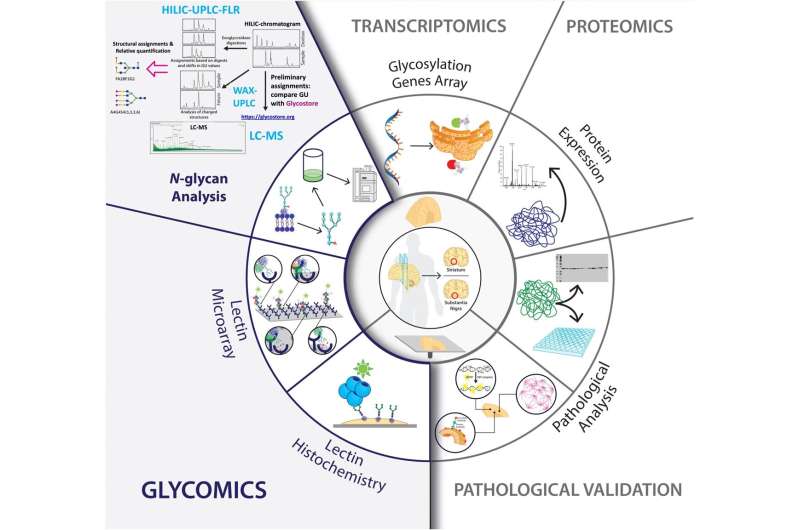This article has been reviewed according to Science X's editorial process and policies. Editors have highlighted the following attributes while ensuring the content's credibility:
fact-checked
peer-reviewed publication
trusted source
proofread
Researchers advance understanding of Parkinson's disease

Researchers have for the first time identified critical targets in the molecular signature of Parkinson's disease across different stages of the disease's progression.
The results of their research are published in PNAS Nexus.
More than 10 million people are living with Parkinson's disease worldwide, making it the second-most common neurodegenerative disease after Alzheimer's disease.
The complete molecular signature of Parkinson's, however, remains unclear. In particular, untangling molecules related to the disease called glycans has been challenging due to their complexity and lack of analytical tools. Glycans (sugars) are found on the cell's surface and are fundamental in ensuring the correct flow of information between cells. Glycans participate in cell-to-cell communication by attaching to other molecules, such as fats (lipids) and proteins.
The research provides a complete characterization of the glycans associated with the connections in the brain that are affected by Parkinson's disease. These findings can potentially advance the development of glycan-focused therapeutic devices to treat and diagnose Parkinson's.
The study included researchers at CÚRAM, the SFI Research Centre for Medical Devices based at the University of Galway, together with collaborators at the Medical University of South Carolina and Vienna University of Technology,
Professor Abhay Pandit, Scientific Director of CÚRAM and project lead, said, "The work presented here will act as a valuable resource for subsequent investigations into the impact of brain glycans on neurodegeneration. It has been established that modifications in glycans have a bearing on other physiological aspects, which could potentially serve as catalysts for additional degeneration."
"Our study has specifically focused on Parkinson's disease, but there are other neurodegenerative conditions for which the glycan environment remains unexplored, and this research will therefore lay the groundwork for future studies on other diseases."
Ana Lúcia Rebelo, the lead author of the study, said, "In this study, we aimed to specifically look at a side of the Parkinsonian brain that was previously unexplored—the glycome. This research is a significant step towards understanding, in-depth, what is happening in this life-altering condition and exploring other therapeutic avenues that could target previously unaccounted-for changes."
"Emerging technologies currently in development will be instrumental in expanding upon the preliminary 'glyco' characterization that has been initiated with this research, culminating in further discoveries in the future."
More information: Ana Lúcia Rebelo et al, Changes in tissue protein N-glycosylation and associated molecular signature occur in the human Parkinsonian brain in a region-specific manner, PNAS Nexus (2023). DOI: 10.1093/pnasnexus/pgad439



















